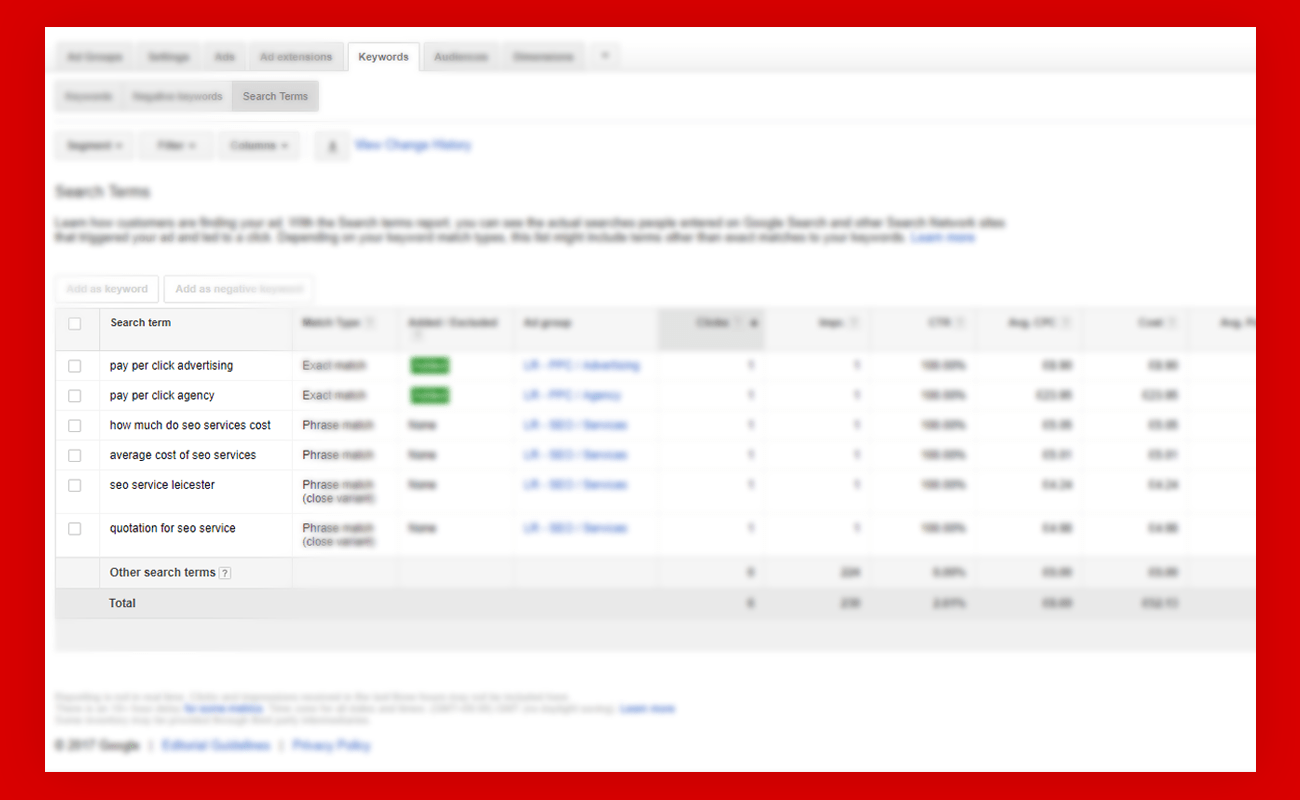As a B2B company, it can be very difficult to effectively manage your PPC marketing. Your cost per clicks are usually astronomical due to low search volumes and high competition. Which makes negative keywords essential in making sure you are getting the right traffic based on your campaign goals.
What are negative keywords?
They can be a single word or an entire phrase that will stop your advert from showing if used in the search term. The best way to hone in on your target keywords is to check what keywords people searched for when clicking on your ad.
You can do this by clicking the Keywords tab in AdWords and clicking Search Terms. Use this list to remove unrelated search terms by adding useless keywords to your negative keyword list. Just select the keyword and press Add as negative keyword.

How do they work?
Negative keywords work much in the same way as your bog-standard keywords. There’s exact match, phrase match, modified broad match and standard broad match. This level of customisation gives you the freedom to get very creative. You’ll be able to trim away every single piece of traffic you do not want.
A leading source of bad traffic for AdWords campaigns comes from search terms containing “discount” or “cheap”. Although these terms can be effective at building impressions, they may not always be the right impressions to achieve targeted conversions.
Unless you are the cost leader in your industry, these terms will more than likely lead to low conversion rates, especially with the likes of Amazon and eBay. Spend time eliminating these keywords and to prevent getting in a bidding-war with your competitors.
Focus on showing potential buyers every other benefit of buying from your business. Whether it’s customer service, great returns policy or free delivery, you need to really push the USPs of your company. You’ll be saving yourself money in the long run.

For e-commerce sites, it is a good idea to build negative keyword lists based on educational traffic. This is the traffic that is coming to your website to find out the HOW or WHY of your products/services.
For example, if you’re a car garage that sells motor oil, you don’t want to be found for people searching HOW to change car oil. If they’re searching for how to do it, they probably already have the product. Focus your spend on people who definitely want to buy.
The longer your campaign runs, the easier it becomes to optimise them due to the historical data available. But don’t worry, there are some basic “default” keywords lists that you can apply straight off the bat. This will help you initially save money.
Negative Keyword Lists
Bargain Terms: bargain, cheap, discount, free, clearance.
General Terms: mp3, nude, porn, sex, torrent
Job Terms: CV, job, jobs, full time, work
Group Terms: tutorial, workshop, association, classes, class
Educational Terms: create, do it yourself, how to, homemade, hand made.
Website Terms: amazon, ebay, youtube, pinterest, facebook
Obviously, you only use these terms as and when required. Some may not be relevant, some may be incredibly relevant. You will need to monitor your campaigns constantly to make sure your negative keywords lists are optimised.
Also, don’t forget you have a campaign limit of 10,000 negative keywords, so get building those lists.

My summary
Negative keywords are a strategic MUST for anybody venturing into Google AdWords. It’s a relatively simple way to save yourself lots of money and increase the efficiency of your campaigns.
If you’re interested in diving into the world of AdWords, we’ve put together a great introduction to PPC marketing
For anything else, you can always contact me directly on 01472 878 496 or alternatively email me on [email]marketing@laser.red[/email]